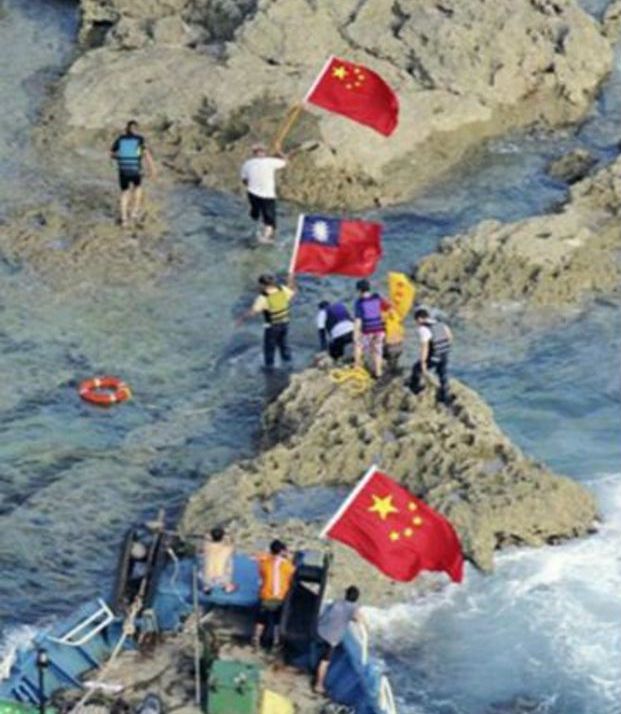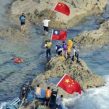
Diaoyu-Senkaku Crisis Tests Resilience of Beijing’s Japan Diplomacy
Publication: China Brief Volume: 12 Issue: 17

The late patriarch Deng Xiaoping said famously about U.S.-China relations: “There are limits as to how good—or how bad—Sino-U.S. ties can become.” Can the same be said for China and Japan? While relations between the two most powerful Asian countries have apparently been heading toward a downward spiral since the early 2000s, the on-going row over sovereignty claims over the Diaoyu islets (known in Japan as the Senkakus) also demonstrates a considerable degree of willingness by the Chinese Communist Party (CCP) leadership to keep the altercations within manageable parameters. This is despite the fact that a number of high-profile Chinese commentators—who have cast themselves as the victims of “Japanese neo-imperialism”—have threatened to resort to arms to settle the 40-year-old dispute.
The latest run-in between both countries, which was ignited when several Hong Kong “patriots” landed on the Diaoyu-Senkaku islets on August 15, has proven to be particularly ferocious. Echoing the horrendous anti-Japanese demonstrations in 2005, tens of thousands of nationalists in the last two weeks staged rallies in more than 20 cities throughout the country. Late last month, a protestor in Beijing even ripped off the flag from the Japanese ambassador’s car (Ming Pao [Hong Kong], August 27; Sina.com, August 28).
The official Chinese press was replete with hard-line if not war-mongering voices. Major General Peng Guangqian proposed Beijing dispatch personnel to the Diaoyu islets for purposes of conducting scientific and environmentally-related research. “If Japan dares to dispatch soldiers [to stop the Chinese], we’d retaliate with missiles,” wrote General Peng. Renmin University social sciences professor Chen Xiankui went one better by suggesting the People’s Liberation Army (PLA) conduct “regular war games in the vicinity of the Diaoyu islands” so as to better demonstrate Chinese sovereignty. In a similar vein, popular commentator Major General Luo Yuan suggested the Diaoyu islets become a “shooting range for the PLA Navy and Air Force” should Japan dare to boost its military presence near the archipelago (Wen Wei Po [Hong Kong], August 30; Sohu.com [Beijing], August 24; Global Times, August 24; People’s Daily, August 21). The usually hawkish Global Times even published a commentary, which was soon carried elsewhere, entitled: “If war breaks out between China and Japan, it will be a war that washes away the humiliation that China has suffered the past century” (Global Times, August 27; Sina.com, August 28).
The Japanese administration also seems to be displaying signs of unusual combativeness. While Tokyo has stuck to its long-standing policy of not allowing members of right-wing organizations to land on the archipelago, the Democratic Party of Japan (DPJ) administration of Prime Minister Noda Yoshihiko is proceeding with plans to “nationalize” the disputed territory through acquiring it from its private owner. Despite the fact that Japan’s public debts are roughly two times its GDP, the Noda government has earmarked extra outlays for maritime defense procurement. Most Chinese commentators have attributed Tokyo’s aggressiveness to the fact that the unpopular DPJ administration is gunning for votes from right-wing sectors in the run-up to probable general elections in November (CCTV, September 1; People’s Daily, September 1).
Yet it is also clear that despite the relentlessly escalating tension, Beijing—and to a considerable extent Tokyo—thinks its national interests are best served if the row over the islets would not degenerate into small-scale naval skirmishes, let alone a full-fledged military conflict. Moreover, both countries seem eager not to allow nationalistic sentiments damage mutually beneficial economic ties. Signs that the CCP administration has been circumspect about the Diaoyu-Senkakus issue are not hard to find. For instance, Beijing has not allowed Chinese NGOs to emulate their Hong Kong counterparts by hiring boats to set sail to the islets [Ming Pao, August 17; Radio Free Asia, August 17]. More significant is the fact that the CCP leadership has this year exercised more restraint compared to 2005, when protests were held against then-Prime Minister Koizumi Junichiro’s visits to the controversial Yasukuni Shrine as well as the “whitewash” of Japanese war crimes in the country’s history books (CCTV, April 25, 2005; Ta Kung Pao [Hong Kong], April 27, 2005).
Immediately upon the outbreak of the first wave of demonstrations on August 19 this year, the CCP Propaganda Department ordered all print and electronic media not to “overplay” the protests. Appeals made by individual firebrands to boycott Japanese merchandises were not allowed to see the light of day. This was despite the fact that a provincial newspaper, the Wuhan Morning Post, listed big-name Japanese firms such as Mitsubishi and Kajima Corporation which had allegedly provided funding and other kinds of support to “right-wing Japanese organizations.” By contrast, an online petition in 2005 appealing to the public to stop buying Japanese products managed to collect about 2 million signatures before it was closed down by authorities (Wuhan Morning Post, August 31; Wen Wei Po, August 31; Ming Pao, August 21).
Moreover, Beijing has so far refrained from using economic weapons to penalize Japan. During the late 2010 Diaoyu-Senkakus crisis, which was precipitated by the detention of the captain of a Chinese fishing junk by Japanese coast guard in the vicinity of the islets, Beijing curtailed the export of rare earth minerals to Japan and restricted the number of Japan-bound Chinese tourists (Ifeng.com [Beijing], October 15, 2010; Southern Daily [Guangzhou], September 28, 2010). This time around, there has been no evidence of “mixing economics with diplomacy” and, given Beijing’s restraint so far, there might not be as the result of this latest incident.
Equally significant is the fact that even at the rhetorical level, the official media late last month ran a number of surprisingly moderate pieces on bilateral ties. For example, the Global Times carried an article by Han Xiaoqing, a senior Tokyo-based correspondent of People’s Daily, that accused the Hong Kong “patriots” who landed on the Diaoyu-Senkakus in mid-August of “having hurt China’s national interests.” Han argued, given that China still required Japanese investment and technology for modernizing its economy, the most rational course would be to heed Deng Xiaoping’s 1978 dictum of “setting aside sovereignty and focusing on joint development.” She offered this advice to pro-Diaoyu nationalists: “Since the time for resolving the Diauyu issue has not arrived, desist from rattling the sensitive nerves [of both peoples] and desist from challenging the limits of both peoples’ tolerance” (Ming Pao, August 28; Global Times, August 27).
Indeed, strong symbiotic economic links between the two powerful neighbors may predispose both capitals to adopt rational measures to resolve the sovereignty disputes. The phenomenon of “cold politics, hot economics” has characterized bilateral relations since the Koizumi era—and it is possible that the same rationale will prevent a rupture of relations now that both countries are facing tough economic realities. The Japanese economy seems to be running out of steam. The still-healthy sales of Japanese cars and other products in the China market are one of the few silver linings on the horizon. For the first time in recent memory, the Chinese economy is having problems maintaining taken-for-granted high-growth rates. As exports to the United States and European Union are slumping, major Asian markets, including that of Japan, have assumed added importance. Moreover, Chinese manufacturers are still eager to acquire Japanese know-how in areas ranging from information to green technology (FtChinese.com [Beijing] August 26; Sohu.com, May 13).
Moreover, quite a number of commentators have viewed the Diaoyu-Senkaku imbroglio via the prism of power politics in the region, especially the long-standing involvement of the United States in Pacific affairs. Instead of focusing on ways and means of snatching the Diaoyus from the Japanese right-wingers, these experts have dwelled on the more long-term strategy of dissuading Tokyo from hitching itself onto the bandwagon of Washington’s alleged “anti-China containment policy.” While speaking at an academic conference marking the 40th anniversary of the establishment of ties between China and Japan, former State Councilor Tang Jiaxuan pointed out Washington was behind the Sino-Japanese discord. “If Japan were willing to give up [the policy of] joining the United States in containing China, [tension between] China and Japan will cool down,” Tang said. “Japan should undertake a fundamental strategic make-over,” he added, “Instead of helping the [United States] tackle China, Tokyo should become the bridge between China and the [United States]” (China Daily, August 29; People’s Daily, August 29).
Similarly, in a commentary on the Diaoyu-Senkakus standoff, the Global Times dwelled on the intriguing China-Japan-U.S. triangle. “The era of Japan’s friendliness toward China is over,” wrote the paper. “Japan’s enmity toward China is more entrenched than that of the U.S…. Compared to South Korea, Japan is a lot further away from China; yet it is very tightly bundled together with the U.S.” The paper concluded “Japan’s foreign-affairs strategy has gone awry: this is the underlying cause of the current nervousness in China-Japan ties” (Global Times, August 29). The implicit corollary of these views is, once Japan has chosen to disengage itself from the perceived Washington-led encirclement policy against China, the Diaoyu-Senkaku problem will cease to wreak havoc on bilateral ties. Apparently anti-Japan scholars such as Renmin University’s Chen have gone so far as to suggest, if Tokyo were willing to say no to the U.S. containment policy, Beijing should support Japan’s bid to become a permanent member of the United Nations Security Council (Milchina.com [Beijing], August 24; News.21cn.com [Beijing], August 24).
Yet another crucial geopolitical development is Tokyo’s intensifying territorial struggle with Seoul and Moscow over respectively the Takeshima Island (called Dokdo in South Korea) and the Northern Territories (called the South Kuril Islands in Russia). Compared with the Diaoyu-Senkaku row, the Japanese government suffers a disadvantage to the extent that Seoul and Moscow exercise de facto control over the islands in question. Hard-line commentators in Beijing have called for some form of an alliance with South Korea and Russia to put pressure on Tokyo. This means Beijing, which has so far displayed neutrality over these disputes, would side with South Korea and Russia in return for these countries supporting China’s claims over the Diaoyu-Senkakus. For example, the Global Times indicated in an editorial last month that “China should support the territorial claims of Russia and South Korea so that [the three countries] can jointly deal with Japan” (Global Times, August 13; Sina.com, August 13). Beijing seems confident that, despite the Japanese government’s apparent ability to secure U.S. support over the Diaoyu-Senkaku issue, it has in its disposal carrot-and-stick ploys to persuade Tokyo to at least prevent the sovereignty row from escalating into a full-blown bilateral crisis.





